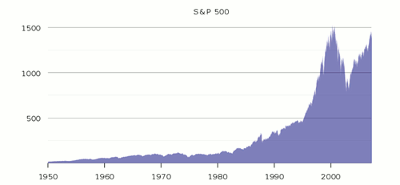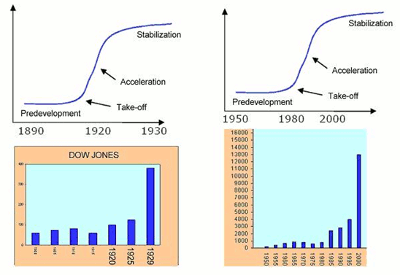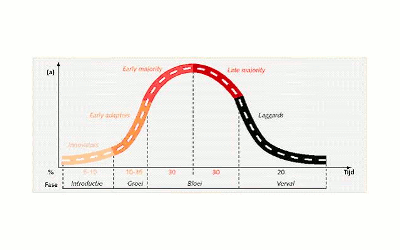Dow2009 = (x1 + x2 + ........ + x30) / 0,132319125
In the nineties of the last century many shares were split. To make sure the result of the calculation remained the same both the number of shares and the divider changed (which I think is wrong). An increase in share value of 1 dollar of the set of shares in 2009 results is 7.5 times more points than in 1985. The fact that in the 1990-ies many shares were split is probably the cause of the exponential growth of the Dow Jones index. At the moment the Dow is at 9665 points. If we used the 1985 formula it would be at 1279 points.
· The most remarkable characteristic is of course the constantly changing set of shares. Generally speaking, the companies that are removed from the set are in a stabilization or degeneration phase. Companies in a take off phase or acceleration phase are added to the set. This greatly increases the chance that the index will rise rather than go down. This is obvious, especially when this is done during the acceleration phase of a transition.
From 1980 onward 7 ICT companies (3M, AT&T, Cisco, HP, IBM, Intel, Microsoft) , the engines of the latest revolution were added to the Dow Jones and 5 financial institutions, which always play an important role in every transition.
This is actually a kind of pyramid scheme. All goes well as long as companies are added that are in their take off phase or acceleration phase. At the end of a transition, however, there will be fewer companies in those phases.

Advertisement
Figure 3: 3rd industrial revolution and the S&P 500

Figure 4: The two most recent revolutions and the Dow Jones Index.
The stock value increase has accelerated enourmously during the acceleration phase.
Will the share indexes go down any further?
Calculating share indexes as described above and showing indexes in historical graphs is a useful way to show which the industrial revolution is in.

Advertisement
Figure 5: Typical course of market development: Introduction, Growth, Flourishing and Decline
The third industrial revolution is clearly in the saturation and degeneration phase. This phase can be recognized by the saturation of the market and the increasing competition. Only the strongest companies can withstand the competition or take over their competitors (like for example the take-overs by Oracle and Microsoft in the past few years). The information technology world has not seen any significant technical changes recently, despite what the American marketing machine wants us to believe.
During the pre development phase and the take off phase of a transition many new companies spring into existence. This is a diverging process. Especially financial institutions play an important role here as these phases require a lot of money. The graphs showing the wages paid in the financial sector therefore shows the same S curve as both revolutions.
This article was published in March 2011 in a magazine entitled “Hermes,” for the Flemish Association for Teachers of Science and History and Culture in June 2011 in the journal of economic education of the VECON, Association of Teachers in the economic\social subjects in the Netherlands.
Discuss in our Forums
See what other readers are saying about this article!
Click here to read & post comments.
2 posts so far.